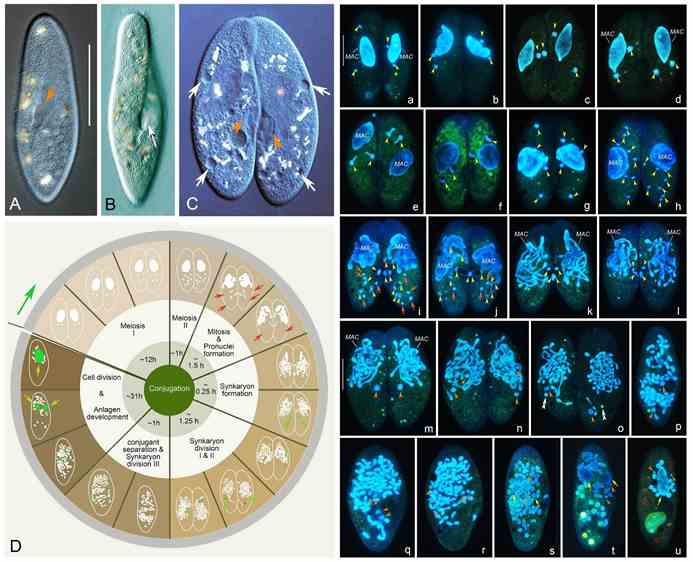Unveiling the Wonders of Ciliate Conjugation: Insights from Paramecium jenningsi
Published 22 November, 2023
Ciliate protozoa possess the remarkable ability to reproduce through both asexual and sexual means. Their distinctive sexual process involves conjugation and autogamy, and they wield a secret weapon: extraordinary nuclear dimorphism. Within each cell resides both a germline micronucleus (MIC) and a somatic macronucleus (MAC). When subjected to fluorescent staining, their sexual processes transform into a captivating kaleidoscope of vibrant colors, creating a cellular carnival of vibrant colors.
To investigate these processes in closely related species, an international team of researchers focused on Paramecium jenningsi, a relative within the P. aurelia complex (a star in the cellular cosmos).
The team found that in P. jenningsi, the conjugation process unfolds over approximately 48 hours, encompassing three prezygotic divisions (meiosis I, II, and mitosis) and three postzygotic divisions. Notably, during this process, the MICs are predominantly characterized by the "parachute" phase occurring at the prophase of meiosis I.
“Following meiosis II, a variable number of nuclei undergo the third prezygotic division. The two resulting products near the paroral cone subsequently evolve into the genetically identical migratory and stationary pronuclei,” shared the study’s co-first author Ruitao Gong.
Further, the synkaryon, formed during conjugation, undergoes three divisions, giving rise to the MIC and MAC anlagen. Interestingly, only one nuclear product from the first postzygotic division proceeds to complete the subsequent two divisions.
“An additional cell division becomes necessary to finalize the last phase of conjugation. During this step, two MIC anlagen undergo mitotic division, while two MAC anlagen are distributed between the daughter cells without division,” added Xue Zhang, the other co-first author.
This study, published in the KeAi journal Water Biology and Security, provides a new model ciliate for further investigation of nuclear selection and differentiation, as well as nuclear morphology during meiosis.
“The process of conjugation in ciliates is truly remarkable. In fact, in other species, we have observed that individuals lacking micronuclei can also engage in conjugation,” said Zhang.

Contact author name, affiliation, email address: Yaohan Jiang (jiangyaohan1993@163.com), Institute of Evolution & Marine Biodiversity, Ocean University of China, Qingdao 266003, China.
Funder: This work was supported by the National Natural Science Foundation of China (No. 32270539, 31961123002), the Natural Science Foundation of Shandong Province (ZR2020JQ13), and the Fundamental Research Funds for the Central Universities (202141004).
Conflict of interest: The authors declare that they have no known competing financial interests or personal relationships that could have appeared to influence the work reported in this paper. Weibo Song is an editorial board member for Water Biology and Security and was not involved in the editorial review or the decision to publish this article.
See the article: Zhang X., Gong R.T., Jiang Y.H., Lu X.T., Wu C.Y., Wang L.H., Ma H.W., Zhang Z.X., Song W.B., Al-Rasheid K.A.S., Vallesi A., Gao F. Nuclear events during conjugation in the poorly studied model ciliate Paramecium jenningsi. Water Biology and Security, 2023: 100201.
https://doi.org/10.1016/j.watbs.2023.100201